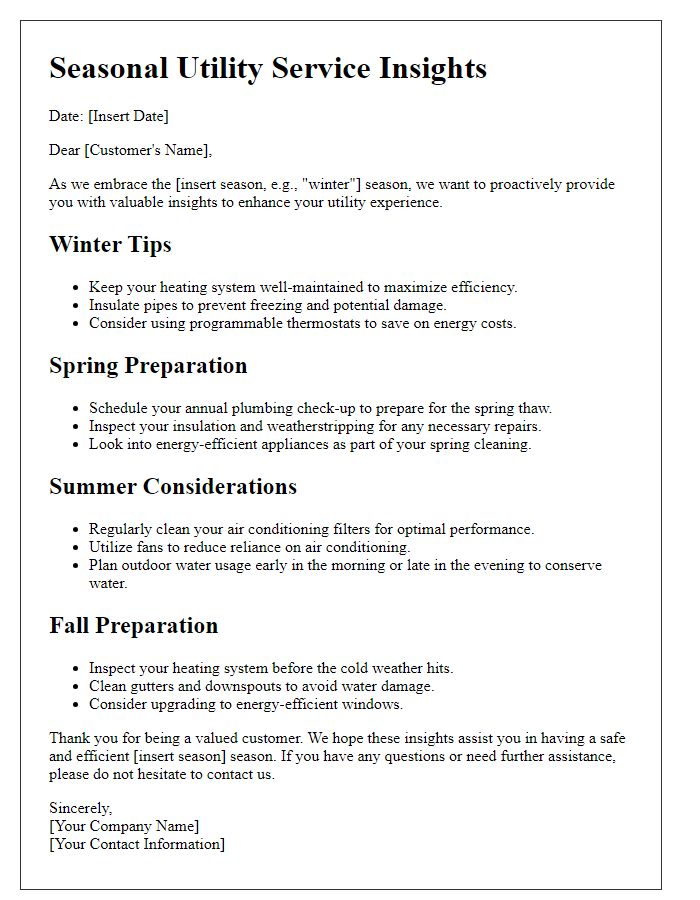As the seasons change, so do our utility needs, and it's essential to stay ahead of the curve. Whether you're looking to save on energy bills or ensure your home is prepared for the winter chill, having a solid plan can make all the difference. From adjusting your thermostat to insulating pipes, small tweaks can lead to big savings. Ready to dive into some practical seasonal service tips? Read on!

Energy-saving appliance recommendations
Energy-efficient appliances can significantly reduce power consumption, lowering utility bills and decreasing overall environmental impact. For instance, ENERGY STAR certified refrigerators can use up to 15 percent less energy than non-certified models, consuming approximately 400 kilowatt-hours annually. Additionally, washing machines with high efficiency ratings utilize around 25 percent less energy and 33 percent less water per load compared to traditional units, averaging about 150 kWh per year. Switching to LED lighting can reduce electricity usage by up to 80 percent, with bulbs lasting up to 25,000 hours. Utilizing smart thermostats, such as the Nest Learning Thermostat, can optimize heating and cooling systems, resulting in energy savings of approximately 10-15 percent on annual energy costs. Embracing these energy-saving appliances can lead to substantial savings, contributing to both personal finances and a sustainable future.
Insulation and weatherproofing guidance
Proper insulation and weatherproofing are crucial for enhancing the energy efficiency of homes, particularly in areas experiencing extreme weather conditions, such as winters in the Northeastern United States. Insulation materials like fiberglass, cellulose, or foam (rated between R-30 to R-60 for attics) can significantly reduce heat loss, resulting in lower utility bills. Weatherproofing techniques, including sealing gaps in windows and doors with caulk or weatherstripping, can prevent drafts and enhance comfort. The U.S. Department of Energy recommends inspecting these areas annually, especially before the onset of winter, to ensure optimal performance and safety. Implementing these tips not only conserves energy but also contributes to sustainability efforts by decreasing overall carbon footprints.
Seasonal maintenance checklists
Seasonal maintenance checklists can enhance the efficiency and longevity of home utilities, such as heating, ventilation, and air conditioning (HVAC) systems. For winter preparations, homeowners should inspect furnaces for proper operation and replace air filters monthly to ensure clean air circulation. In spring, it's vital to clean air conditioning units, checking ducts for debris while ensuring the thermostat settings are accurate for optimal cooling. Regularly inspecting smoke alarms and carbon monoxide detectors, particularly during daylight saving time changes, can prevent dangers associated with household fires and toxic gas leaks. Outdoor maintenance includes gutter cleaning and examining landscaping around water lines to prevent clogs and potential pipe freezes, especially in areas experiencing drastic temperature fluctuations, such as the Midwest or Northeast United States.
Efficient thermostat usage strategies
Efficient thermostat usage strategies can significantly reduce energy consumption and costs for homeowners. Programmable thermostats allow users to set specific temperature schedules, optimizing heating and cooling based on daily routines. By maintaining the temperature at 68 degrees Fahrenheit during winter months, energy usage can decrease by up to 10%. In summer, setting the thermostat to 78 degrees Fahrenheit can enhance comfort while minimizing costs. Utilizing smart thermostats can provide real-time energy usage insights and remote control via smartphone apps. Regular maintenance, such as changing air filters, ensures optimal airflow and efficiency. Additionally, eliminating drafts by sealing windows and doors can help maintain desired temperatures more efficiently.
Emergency preparedness tips
Emergency preparedness is crucial for utility service customers, particularly during seasonal challenges like winter storms or summer heatwaves. Residents should stock up on essential supplies including non-perishable food items, bottled water (at least one gallon per person per day for three days), and first aid kits. Keeping flashlights with fresh batteries on hand (consider stockpiling extra batteries) is vital for any power outages. Homeowners should also confirm their emergency contact list includes local utility numbers (such as Xcel Energy) for reporting outages or downed lines. Additionally, having a battery-powered radio can provide critical information during emergencies. It's beneficial to develop a family communication plan, ensuring all members know how to reach one another and where to meet. Regularly checking your home's emergency preparations allows for necessary updates, ensuring your family stays safe and informed when unexpected utility disruptions occur.













Comments